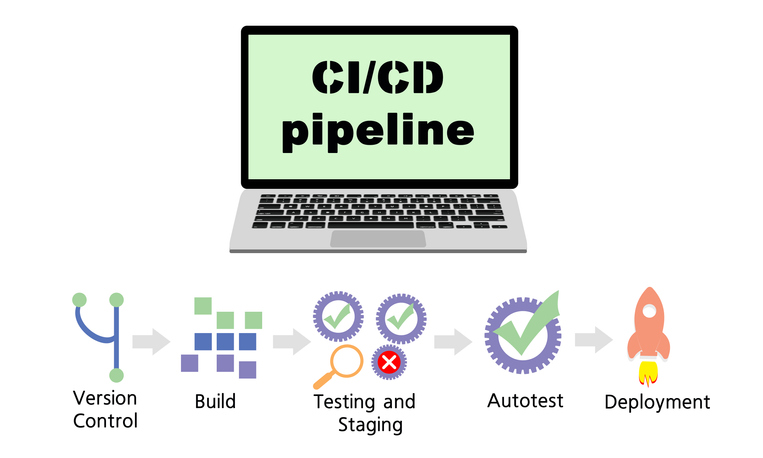Continuous Integration and Continuous Delivery (CI/CD): The pillars of development agility
In the world of software development, the adoption of continuous integration (CI) and continuous delivery (CD) is a must. CI/CD makes it possible to automate the development pipeline, accelerate product delivery, and improve the quality delivered to end users
What is CI/CD?
Continuous Integration (CI) : This is a set of practices that allow developers to automatically merge code changes into a centralized repository, thus promoting a unified codebase. This not only accelerates the application creation and testing process but also ensures the software’s integrity with each update. By integrating and testing regularly, teams can detect and resolve quality issues quickly, preventing the accumulation of bugs.
Continuous Delivery (CD) : This practice allows all validated code changes to be automatically deployed from the repository to the production environment. It ensures that the most recent version of the software is always available,minimizing time to market and improving responsiveness to customer needs.
The Benefits of CI/CD in a Few Figures
- Reduced time to market: Organizations that adopt CI/CD have seen a 50-70% reduction in time to market.
- Improved quality: CI/CD practices contribute to an average 30% decrease in release failure rates, ensuring greater stability and reliability of delivered software.
- Reduced costs: By automating development and delivery, companies can save up to 20% of initial development costs by reducing the need for manual labor and decreasing the frequency of human error.
Investing in appropriate tools to build a robust CI/CD pipeline is therefore essential. Not only do these tools support smooth integration and deployment, but they also reinforce the agility and competitiveness of development teams in an ever-evolving market.
What are the criteria for choosing the right CI/CD tools?
There are dozens of tools according to the “State of DevOps” from Puppet, here are the different criteria that you must take into account before choosing yours:
- Integration with other tools: The chosen tool must be able to integrate easily with version control systems like Git, container repositories, etc. Native integration is crucial to create a fluid workflow and avoid development silos that can slow down the delivery process.
- Ease of use and configuration: A CI/CD tool should have an intuitive user interface and allow for easy configuration of pipelines. This reduces the necessary onboarding time and allows developers to focus on creating value rather than managing tools.
- Scalability and performance: The tool must be designed to grow with your business. It must be able to handle projects of all sizes and respond quickly even during peak loads to guarantee the performance of pipelines.
- Security and compliance: It must offer advanced security features such as fine-grained authorization management and align with security standards and regulations in force to protect code and data throughout the deployment pipeline.
- Community support and documentation: A well-documented tool with an active community helps reduce troubleshooting time and improve overall team efficiency. In addition, the availability of resources helps keep the team up-to-date on best practices and new features.

Our selection of the best CI/CD tools in 2024
Jenkins X :
Description : An evolution of Jenkins, specifically designed for the cloud and Kubernetes, offering automated pipelines from the start.
Features:
- Simple and user-friendly user interface
- Seamless integration with major cloud platforms like Azure, Google Cloud, Amazon Web Services, Slack, and Digital Ocean
- Master-slave architecture allowing for efficient resource utilization
- Real-time testing and reporting
- Over 1500 plugins and a dynamic community
GitHub Actions :
Description : Enables powerful automation directly from GitHub repositories, offering customization and execution of software development workflows.
Features:
- Full integration with GitHub
- Built-in secrets store
- Multiple CI templates or custom creation
- Live log for real-time tracking
- Support for matrix builds for different configurations
GitLab CI/CD :
Description : An all-in-one solution for version control and CI/CD, integrating the entire process within the same platform.
Features :
- Direct connection with Kubernetes
- Automatic security scans
- Seamless integration with third-party tools such as Slack, Asana, ClickUp, Notion, and Trello
- Real-time management of collaborative projects
- Visual tools for managing project code and data
CircleCI :
Description : Renowned for its speed and efficiency, CircleCI offers flexible configuration and a wide range of integrations.
Features :
- CircleCI Insights for project status tracking
- Parallel testing on different executors
- One process per project
- CircleCI Orbs for automating repetitive processes
- Tools for troubleshooting and workflow inspection
Travis CI :
Description : One of the CI/CD pioneers, perfect for Open Source projects. It is the ideal platform for GitHub projects,with easy integration and management of multiple configurations.
Key features:
- Proprietary YAML syntax
- Supports multiple languages such as Android, C#, C++, Python, and Javascript
- Live build views for tracking GitHub projects
- Smooth integration with common cloud repositories including GitHub, GitLab, Kubernetes, and Azure
- Supports matrix builds, i.e. running the same builds against multiple configurations and environments
Azure DevOps :
Description : The Microsoft CI/CD solution integrating agile planning and multi-environment deployment, compatible with various platforms.
Key features :
- Azure DevOps agile boards facilitate agile planning and team visualization
- Test management allows the team to plan, create, and execute application tests
- Seamless integration with any GIT repository and various programming languages
- Follows industry standards of YAML syntax
- Accepts any repository for package management
Codefresh :
Description : Kubernetes-based CI/CD tool, offering container pipelines for fast and secure deployments, with a centralized dashboard.
Key features:
- Codefresh’s centralized dashboard provides an overview of large-scale deployments as well as security and support for the development team
- Supports Docker images
- Smooth integration with well-known tools such as Bitbucket, GitHub, GitLab, and Slack
- Enhanced visibility into the build process
- Supports build parallelism
In Conclusion
These tools are not an end in themselves but a means to facilitate and accelerate the development cycle while maintaining high quality and security standards. The rest is to test them to find the ones that best suit your specific needs!
Do you want to implement a CI/CD pipeline in your development teams? Or strengthen your teams with our CI/CD developers? Leave us a message!
Do you need reinforcements for your teams or a quote for a new project?
We offer technical assistance services, fixed-price contracts, or fixed-price contracts with strong commitments in terms of deadlines and budget.
